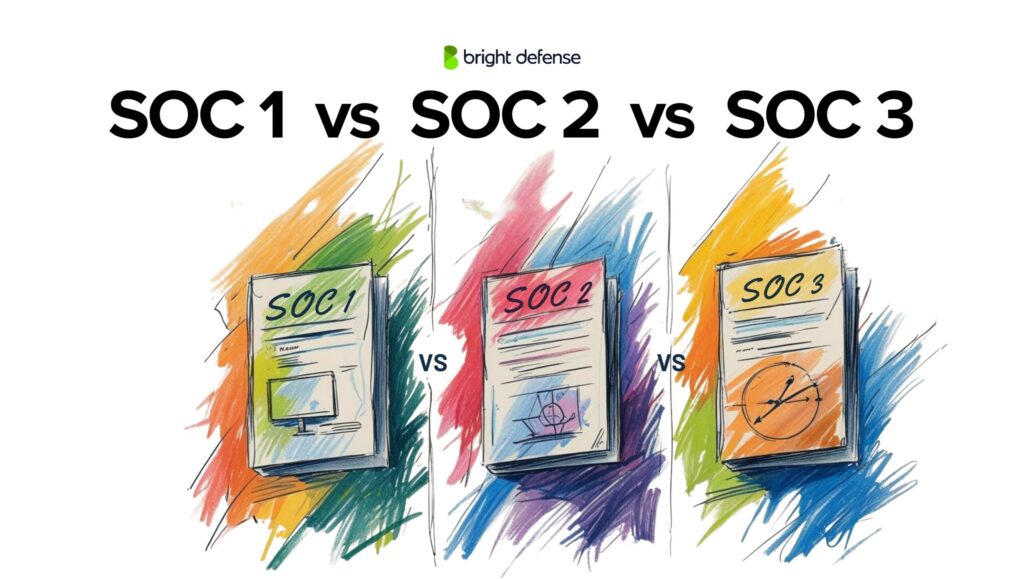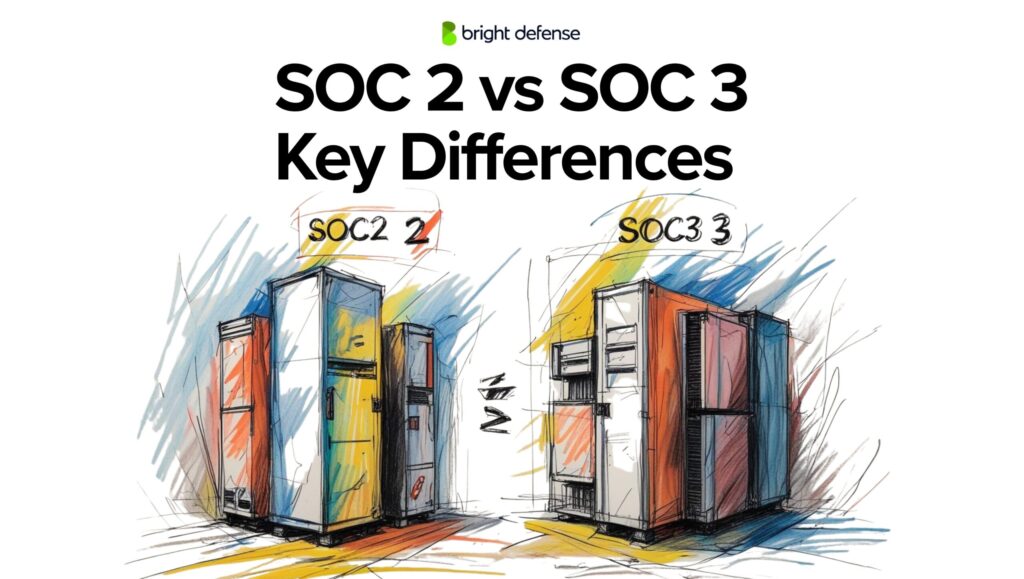
Tim Mektrakarn - CISSP | CISA | ISO 27001
June 28, 2025
Drata vs. Secureframe: A Comprehensive Comparison
Introduction
Drata and Secureframe are both leaders in the compliance automation space. Their solutions are designed to navigate the complexities of cybersecurity compliance, making adhering to industry standards simpler and more efficient. As businesses increasingly prioritize compliance automation, Drata vs. Secureframe is a common comparison.
This comparative analysis highlights these two leading platforms’ unique features, capabilities, and differences. It aids companies in selecting the most suitable tool for their compliance journey. We explore how each platform approaches compliance automation, the range of standards covered, and the available support ecosystems. This exploration reveals what makes Drata and Secureframe distinct and how they can meet the needs of your organization.
Whether you represent a burgeoning startup searching for your first compliance solution or an established enterprise aiming to strengthen your cybersecurity framework, gaining a detailed understanding of Drata vs. Secureframe will empower you. This knowledge enables you to make an informed choice on the compliance automation platform that meets your company’s requirements. Let’s get started!

Overview of Compliance Management
Compliance management ensures companies adhere to industry regulations, standards, and laws. This rigorous process safeguards sensitive data and builds trust with customers and partners by demonstrating a commitment to security and legal conformity. However, the path to achieving and maintaining compliance presents many challenges. These include the evolving regulatory landscape, the complexity of integrating various compliance requirements, and the resource-intensive nature of continuously monitoring compliance.
Automated compliance management solutions like Drata and Secureframe offer solutions to these problems, including:
- Automated Compliance Management: Simplifies the process of maintaining compliance with industry standards through automation, reducing manual effort and errors.
- Real-Time Security Monitoring: Offers continuous oversight of your security posture, ensuring that any deviations from compliance are quickly detected and addressed.
- Effortless Audit Preparation: Organizes and manages all necessary documentation and evidence in a single place, significantly easing the audit process.
- Vulnerability Identification and Remediation Guidance: Quickly identifies security weaknesses and provides actionable insights to secure your infrastructure.
- Centralized Control: Consolidates compliance activities, documentation, and reports into a unified platform for better management and visibility.
- Enhanced Governance and Decision-Making: Improves organizational governance by offering real-time, comprehensive insights into compliance status, helping leaders make informed policy and security decisions.
By leveraging such technologies, businesses can navigate the complexities of compliance management more efficiently, reduce the risk of non-compliance, and free up valuable resources to focus on core business activities.
Drata at a Glance
Drata emerged as a response to the growing need for streamlined, automated compliance solutions in the face of increasingly complex regulatory landscapes. Founded by security and compliance veterans, Drata’s mission revolves around making compliance continuous, integrated, and less burdensome for organizations of all sizes.
This dedication has propelled Drata to the forefront of the compliance management industry, offering a suite of features designed to simplify and strengthen compliance strategies across various sectors. Drata’s $200 million Series C funding round put their valuation at over $2 billion.
Powerful Automated Compliance Monitoring
Key to Drata’s offering is its automated compliance monitoring. This feature that enables businesses to constantly track their adherence to relevant standards and regulations without manual intervention. The automation actively extends to continuous security control monitoring. It promptly detects and addresses any deviations from set security benchmarks, thereby minimizing the risk of non-compliance and security breaches.
Furthermore, Drata’s platform excels in integration capabilities, seamlessly connecting with a multitude of other tools and services. The include Google Cloud, AWS, Azure, Slack, Jira, GitHub, HR Cloud, Gusto, and more. This connectivity ensures that compliance monitoring encompasses all aspects of the business, from HR processes and cloud storage to customer data management and beyond.
Secureframe at a Glance
Secureframe delivered its compliance automation platform to demystify and simplify the path to compliance. Recognizing the challenges that companies face in navigating the intricate web of regulations and standards, Secureframe set out to create a platform that ensures compliance while being efficient and user-friendly.
Founded by experts in cybersecurity and compliance, Secureframe has quickly established itself as a key player, offering innovative and tailored continuous compliance monitoring solutions. Secureframe secured $56 million in funding in a Series B raise in February of 2022.
Process Automation
At the heart of Secureframe’s offerings is compliance process automation. This feature automates the compliance journey by streamlining evidence collection, tracking progress, and managing compliance tasks. It significantly reduces teams’ manual workload.
Secureframe doesn’t stop there. It also emphasizes the human element of compliance through its employee training modules. These modules deliver essential training directly to staff, ensuring that everyone is up-to-date on the latest security practices and compliance requirements. Additionally, Secureframe’s platform includes robust vendor risk management features, enabling companies to assess and manage the compliance and security posture of their third-party vendors effectively.

Feature Comparison: Drata vs. Secureframe
Understanding the specific offerings and capabilities of Drata and Secureframe is crucial for organizations looking to enhance their compliance management processes. Here, we compare the platforms focusing on supported compliance frameworks, ease of use, integration capabilities, and customer support.
Compliance Frameworks Supported
Drata:
- Offers comprehensive support for a wide range of compliance frameworks, including SOC 2, ISO 27001, HIPAA, GDPR, and PCI DSS.
- Regularly updates its offerings to encompass new standards and regulatory requirements, ensuring organizations can stay ahead of compliance needs. Drata was one of the first to offer NIST AI Risk Management Framework.
Secureframe:
- Similar to Drata, Secureframe supports key compliance frameworks such as SOC 2, ISO 27001, HIPAA, and GDPR and even ISO 9001.
- It focuses on providing up-to-date templates and workflows tailored to these standards, ensuring users have the resources they need to achieve compliance.
At the time of this writing, both companies support 19 frameworks:
| Frameworks | Drata | Secureframe |
|---|---|---|
| SOC 2 | X | X |
| HIPAA | X | X |
| GDPR | X | X |
| CCPA | X | X |
| PCI DSS | X | X |
| Cyber Essentials | X | X |
| CMMC | X | X |
| Microsoft SSPA | X | X |
| NIST CSF | X | X |
| NIST SP 800-53 | X | X |
| NIST SP 800-171 | X | X |
| NIST AI RMF | X | |
| FFIEC | X | |
| CCM (Cloud Controls Matrix) | X | |
| ISO 27001 | X | X |
| ISO 27017 | X | |
| ISO 27018 | X | |
| ISO 27701 | X | |
| Custom Frameworks | X | X |
| FedRAMP | X | |
| AWS FTR (Foundational Technical Review) | X | |
| NYDFS NYCRR 500 | X | |
| FTC Safeguards Rule | X | |
| CJIS | X | |
| CPRA | X | |
| ISO 9001 | X |
Ease of Use and User Interface
Drata:
- It features a sleek, intuitive interface that simplifies users’ compliance process.
- Its dashboard provides clear visibility into compliance status, with easy-to-understand metrics and actionable insights.
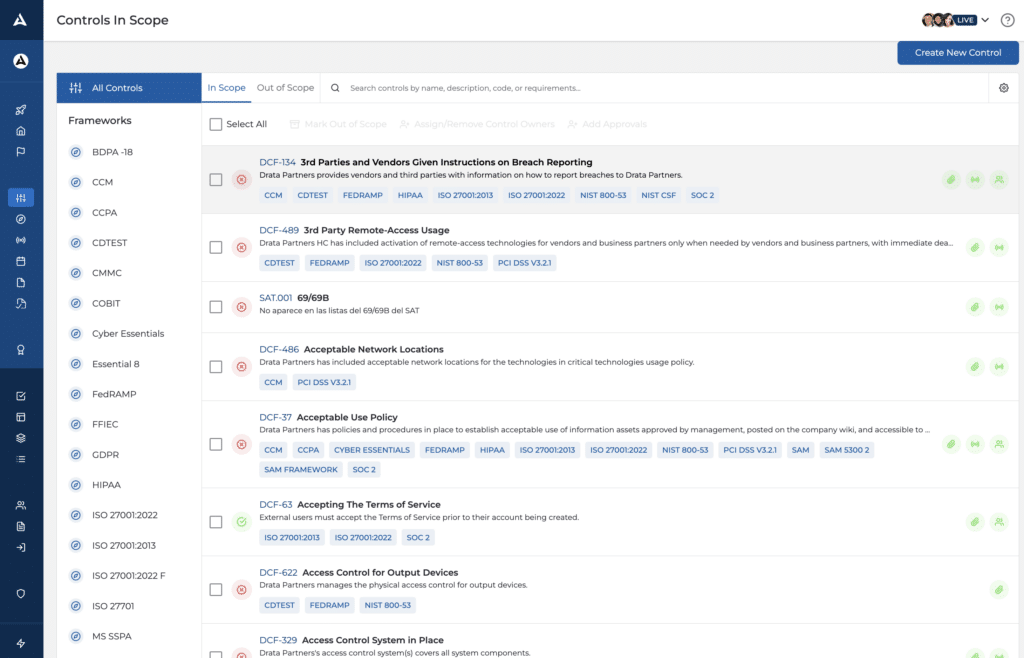
Secureframe:
- Also known for its user-friendly interface, emphasizing guided workflows that help demystify the compliance process.
- Offers clear, concise insights and a straightforward navigation path, making it easy for users to manage their compliance tasks.
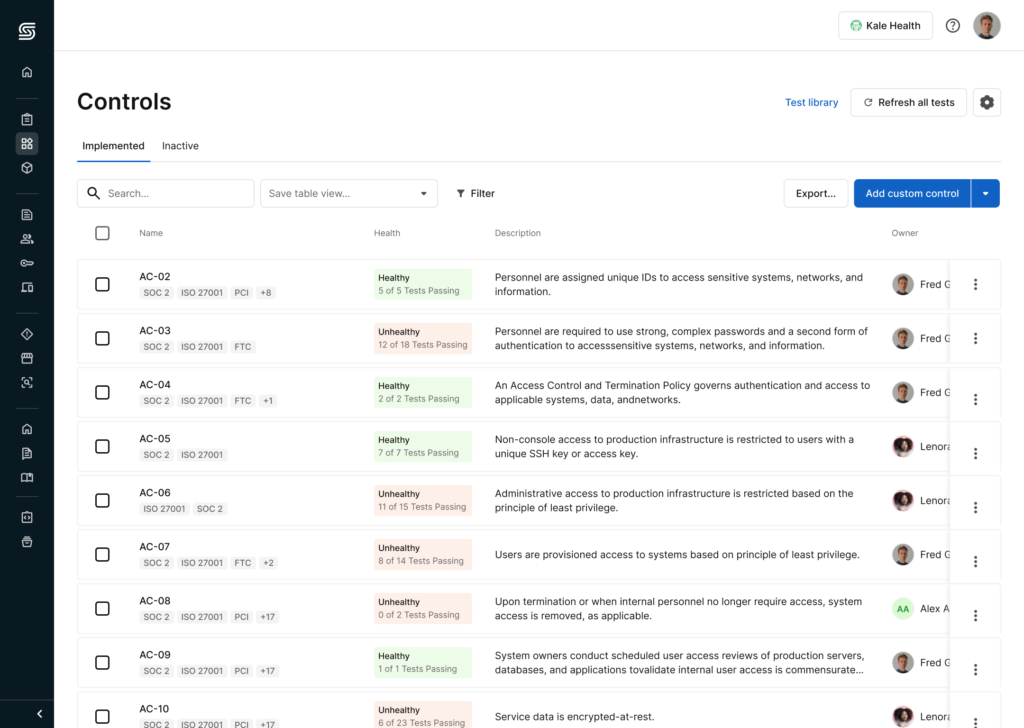
Integration with Existing Tools
Drata:
- Boasts a wide array (140+) of integrations with external tools and services, including cloud services, HR platforms, and task management tools.
- These integrations facilitate the automation of evidence collection and ensure a holistic view of compliance across the business.
- From our experience, Drata’s depth of integrations distinguishes them against their competitors who focus on having a large number of mediocre integrations.
Secureframe:
- Offers a comprehensive suite of integrations (200+), designed to connect easily with the user’s existing tool ecosystem.
- Prioritizes making the connection process as straightforward as possible, enabling efficient, automated compliance management.
Onboarding in each Platform
Drata:
- The Quick Start checklist guides users through the initial setup on the platform, starting with connecting an Identity provider such as Microsoft 365 or Google Workspace. Following this, users enter company details, assign key personnel, and define user roles, among other tasks.
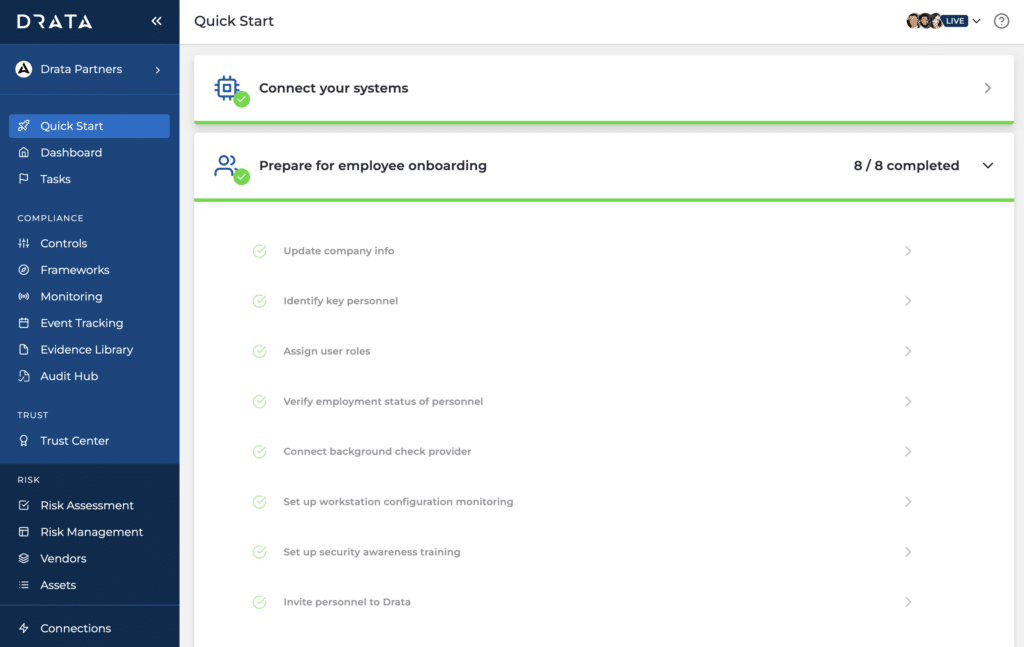
Secureframe:
- It offers an intuitively guided onboarding process that leads the user from entering company details to integrating various services. These include connecting business suites, HR tools, SSO, background checks, cloud services, and MDM providers.
- Secureframe also offers a vendor directory to select vendors easily.
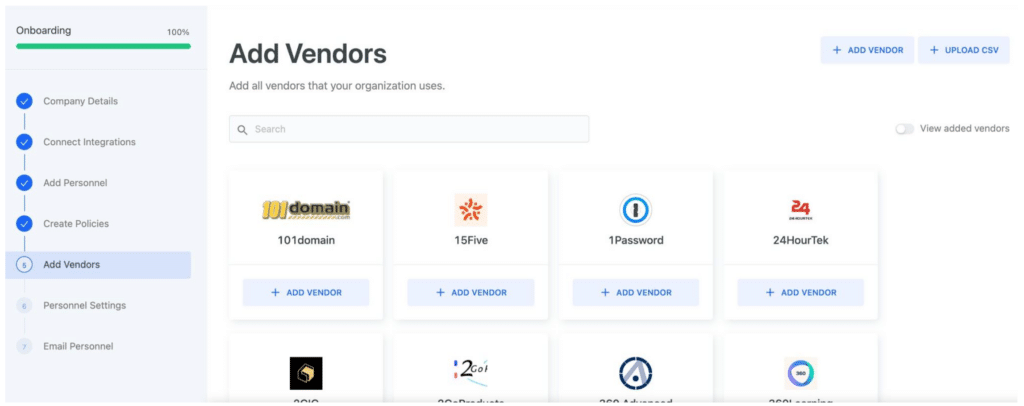
Customer Support and Resources
Drata:
- Provides dedicated customer success teams, extensive documentation, and an online resource center filled with compliance guides and best practices.
- Focuses on a hands-on approach to support, aiming to empower users with the knowledge to tackle compliance confidently.
Secureframe:
- Ensures users have access to compliance experts and responsive customer service teams.
- Secureframe’s documentation is lagging behind Drata’s in terms of details and thoroughness. For example Secureframe’s Integrations guide only contains 6 articles compared to Drata’s showing over 125 pages.
In comparing Secureframe vs Drata, it’s evident that both platforms offer robust solutions tailored to modern compliance management needs. Each platform excels by supporting critical compliance frameworks, offering user-friendly interfaces, and enabling seamless integrations with other tools. They also provide comprehensive customer support.
The decision to choose between Drata and Secureframe will likely depend on the organization’s specific needs, preferences for user interface design, integration requirements, and the desired level of customer support. Both platforms actively work to make compliance accessible and manageable. They enable companies to concentrate on growth while maintaining compliance.

Pros and Cons of Secureframe vs Drata
Understanding the strengths and limitations of Secureframe and Drata can help businesses make more informed decisions. Below is a summary of the advantages and disadvantages associated with each platform.
Secureframe
Pros:
- Automated Workflows for Compliance: Secureframe simplifies the compliance process with its automation of evidence collection, monitoring, and reporting, significantly saving time and resources.
- Employee Training Modules: Unique to Secureframe, these modules provide essential training to staff, ensuring everyone is informed on compliance and security practices.
- Vendor Risk Management: Offers specialized features for managing third-party vendor risks, a crucial aspect for businesses relying on external services and products.
- User-Friendly Experience: With guided workflows and a clear interface, Secureframe makes managing compliance tasks straightforward and accessible for users of all expertise levels.
Cons:
- Framework Coverage: While Secureframe supports major compliance frameworks, businesses needing support for less common or emerging standards may need to verify coverage.
- Working out the Bugs: Many reviewers on G2 have mentioned the numerous bugs they ran into while using the platform although Secureframe was quick to resolve them.
- Verify Test Results: The results of tests from the integrations in Secureframe need to be thoroughly verified and users review what the tests really examine and not rely just on the status.
- No API: Secureframe does not offer an API to customize or automate tasks
Drata
Pros:
- Automated compliance monitoring: Offers robust automation features for compliance monitoring, reducing the manual effort required and minimizing the risk of human error.
- Seamless Integrations: Drata’s extensive integration capabilities ensure that companies can easily connect their existing tools and systems, facilitating a unified approach to compliance management.
- Intuitive User Interface: The platform’s sleek and intuitive interface enhances user experience, making it easier to navigate compliance processes and access necessary information.
- Detailed Documentation: Drata has invested in building a comprehensive documentation library that makes it easy to use their product.
Cons:
- Learning Curve: While the platform is designed to be user-friendly, the breadth of features and capabilities might require a learning period for new users to fully leverage the platform’s potential.
- Risk Management Not Included: As a premium product, Drata makes you pay extra for Risk Management while others include it as part of the core offering.
Both Secureframe and Drata offer compelling features tailored to ease the compliance management burden for businesses. Drata stands out for its broad compliance framework support and sophisticated automation capabilities, making it suitable for organizations looking for comprehensive compliance solutions.
Secureframe, with its focus on user education through training modules and robust vendor risk management, presents a strong option for companies prioritizing internal compliance awareness and external vendor security. The choice between Secureframe and Drata will hinge on each business’s unique needs, priorities, and budget constraints. Each platform offers distinct advantages to tackle the multifaceted challenges of compliance management.

Conclusion
In this article, we explored Drata vs Secureframe, two top compliance management solutions. We covered their histories, features, and supported frameworks. We also looked at ease of use, integrations, and customer support. Our comparison highlighted each platform’s strengths and challenges.
Drata stands out for its extensive compliance framework support, advanced automation capabilities for compliance and security monitoring, and their depth of integrations with essential business tools. Drata’s user-friendly interface and dedicated customer support make it an excellent choice for businesses seeking a comprehensive, all-in-one compliance solution.
Secureframe distinguishes itself with automated workflows that simplify the compliance process, unique employee training modules to enhance internal compliance awareness, and robust features for managing vendor risk. Secureframe’s straightforward user interface and strong customer support system render it a solid option for companies prioritizing ease of use and educational resources in their compliance journey.
We encourage readers to closely consider their unique compliance requirements, weigh the pros and cons of each platform, and conduct further research to determine which solution aligns best with their business objectives. Remember, the right compliance management solution not only helps you meet regulatory standards but also enhances your overall security posture and builds trust with your customers and partners. Choose wisely, and let your compliance journey be a stepping stone to greater business success.

About Bright Defense
Bright Defense has tailored its Continuous Cybersecurity Compliance-as-a-Service offerings into three distinct packages. Each package incorporates the use of advanced compliance automation platforms like Drata.
Sentry Package
This package is ideal for those firms that prefer a hands-on approach and have a strong grasp of IT and security practices. It offers access to a block of virtual Chief Information Security Officer (vCISO) hours. These hours can be allocated towards a range of activities, including but not limited to, conducting risk assessments, crafting incident response playbooks, engaging in tabletop exercises for incident response, developing and testing business continuity and disaster recovery plans, providing audit preparation and advice, carrying out internal audits, and strategizing IT planning.
Guardian Package
The Guardian package delivers a fully managed Information Security Program, extending to pre-audit preparation. It’s designed for customers who seek an end-to-end service but wish to have the flexibility of selecting their own auditors for the compliance process.
Defender Package
The Defender package encompasses all the Guardian package’s offerings. It adds an annual SOC 2 audit conducted by a US-based AICPA firm and monthly vulnerability scans. This package is the most complete solution, offering peace of mind through thorough compliance and security measures.
In addition to continuous compliance, we also offer vCISO services, risk assessments, gap analysis, security awareness training, mutlwfactor authentication, and more. Get started on the road to compliance with the compliance experts at Bright Defense!
FAQ: Secureframe vs. Drata
What is audit readiness, and how do compliance automation platforms help?
Audit readiness means being ready for an audit with all needed documents and evidence. Compliance platforms simplify this. They let you upload evidence, ensuring data and systems are well-documented for auditors.
How do these platforms conduct risk assessment?
Risk assessment is performed by continuously monitoring the organization’s systems and processes. These platforms identify vulnerabilities within your assets and use a risk register to prioritize and track them. This helps to implement effective controls and mitigate risks.
Can I manage all my compliance programs with these platforms?
Yes, these platforms are designed to support a variety of compliance programs, including SOC 2 compliance, by centralizing the management of compliance policies, procedures, and documentation. This allows organizations to maintain oversight over multiple standards and regulations.
What is continuous monitoring, and why is it important?
Continuous monitoring is the process of continuously assessing and improving the security of an organization’s information systems and assets. It is crucial for identifying and responding to threats in real time, thereby maintaining compliance and securing data and employee information.
How does a compliance automation platform help with managing compliance policies?
Such platforms provide a single place where organizations can create, store, and manage their compliance policies. This centralized approach ensures that policies are consistently applied across all systems and departments. It also ensures that employees and vendors know and can easily access these policies.
What is a risk register, and how is it used in compliance?
A risk register is a tool for identifying, assessing, and managing risks within an organization. Compliance automation platforms utilize risk registers to keep track of identified risks, assess their potential impact, and prioritize mitigation efforts based on severity. This aids in the effective governance of risk management.
How do compliance automation platforms support SOC 2 compliance?
These platforms aid SOC 2 compliance with tools for continuous monitoring. They focus on security, availability, integrity, confidentiality, and privacy. Automating evidence collection simplifies SOC 2 standard verification for auditors.
Can I integrate external vendors into the compliance process through these platforms?
Yes, many compliance automation platforms allow for the integration of external vendors. This ensures that third-party services and products also adhere to your organization’s compliance standards. This is particularly important for controlling and monitoring the security and compliance of outsourced services.
What types of evidence can I upload to demonstrate compliance?
Organizations can upload various types of evidence. This includes system logs, policies and procedures documents, employee training records, and reports from security systems. This evidence is used to demonstrate the implementation of effective controls and compliance with specified regulations.
Get In Touch


